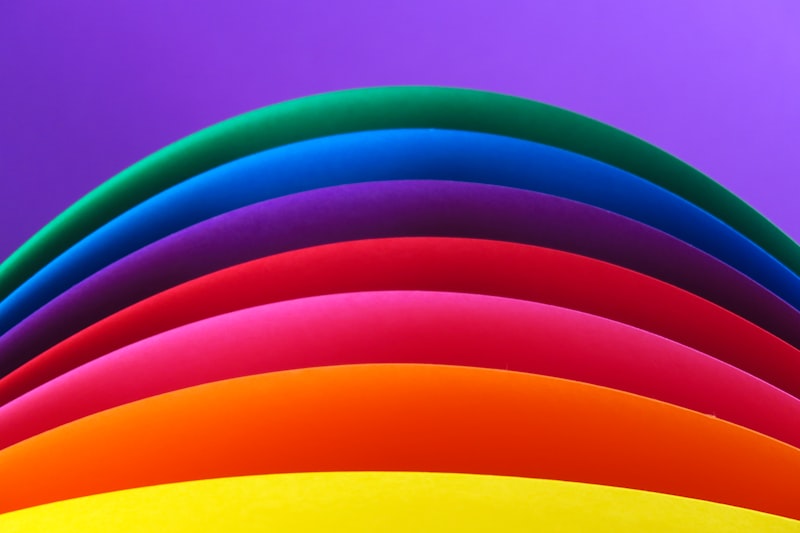- Dream colors hold deep symbolic meanings and can reflect our emotions and thoughts.
- Red symbolizes strong emotions, passion, and intensity, but can also represent anger or frustration.
- Orange signifies energy, enthusiasm, and creativity, but can also indicate a need for caution.
- Yellow represents happiness, joy, and optimism, but can also suggest cowardice or caution.
Understanding the symbolism behind dream colors can provide insight into our subconscious messages. The importance of dream color symbolism and its impact on our psychological and emotional states will be discussed, helping to unravel the meaning of vivid dream colors that sometimes leave us wondering upon waking up.
Interpretation of Common Dream Colors

Dreams are a mysterious and fascinating part of our subconscious mind. They have a language of their own, often conveying messages through symbols and colors. Colors play a significant role in our dreams as they can hold deep symbolic meanings and reflect our emotions and thoughts. In this section, we will explore the interpretation of some common dream colors, delving into their symbolism and what they might reveal about our subconscious.
1. Symbolism of Red in Dreams
- Dreams that feature the color red often represent strong emotions, passion, and intensity.
- Red can symbolize love, desire, and romance. It may indicate a passionate relationship or an intense connection with someone.
- On the other hand, red can also represent anger, frustration, or aggression. It may be a sign that you are feeling strong negative emotions in your waking life.
- Pay attention to the context of the dream to understand whether the red color is associated with positive or negative emotions. This will help you interpret its meaning more accurately.
2. Meaning of Orange in Dreams
- When orange appears in your dreams, it typically signifies energy, enthusiasm, and creativity. It may suggest that you are feeling inspired and motivated.
- Orange also represents sociability and being outgoing. It can indicate a desire to connect with others and engage in social activities.
- However, be aware that orange can also represent caution or a need to proceed with care. If you see orange caution signs or warning symbols in your dream, it may be a sign to exercise caution in your waking life.
3. Interpretation of Yellow in Dreams
- Yellow is often associated with happiness, joy, and optimism. When it appears in your dreams, it may symbolize positivity, enlightenment, and a sense of hope.
- Dreaming of yellow can also reflect your intellect and mental activities. It may suggest a need for clarity, logic, or decision-making in your waking life.
- However, yellow can have negative connotations as well. It might indicate cowardice or caution. Pay attention to how the yellow color is presented in your dream to understand its specific meaning.
4. Connotations of Green in Dreams
- Green is strongly connected to nature, growth, and renewal. When it appears in your dreams, it often signifies harmony, balance, and a sense of peace.
- Dreaming of green can also represent healing, both physically and emotionally. It may suggest that you are going through a period of growth and transformation.
- Additionally, green is associated with money and wealth. It may symbolize financial abundance or a focus on material prosperity.
5. Significance of Blue, Purple, and Pink in Dreams
- Blue is a calming color often associated with tranquility, relaxation, and peace of mind. When it appears in your dreams, it may suggest a need for serenity or a desire for emotional stability.
- Purple represents spirituality, wisdom, and intuition. It is often associated with higher consciousness and enlightenment. Dreaming of purple can indicate a connection to the divine or an inner spiritual transformation.
- Pink is a gentle color that conveys sweetness, love, and affection. When it appears in your dreams, it may symbolize nurturing relationships, emotional healing, or a sense of innocence and purity.
Understanding Black, Gray, Brown, and White in Dreams
- Black is the color of the unknown and mystery. It can represent hidden emotions, unconscious desires, or fear. Dreaming of black may indicate that you are exploring the depths of your subconscious mind.
- Gray often symbolizes neutrality or indecision. It may suggest feelings of uncertainty or confusion in your waking life.
- Brown is associated with stability, grounding, and practicality. Dreaming of brown can indicate a need for a sense of security or a desire for stability in your environment.
- White represents purity, clarity, and new beginnings. It signifies innocence, cleanliness, and a fresh start. Dreaming of white may indicate that you are ready to embark on a new chapter in your life.
Understanding the symbolism of colors in dreams can help you gain insights into your subconscious mind and the emotions and thoughts that may be guiding your waking life. Remember to consider the context of your dreams, your personal associations with each color, and the overall palette of colors presented in your dream. By paying attention to these details, you can unravel the meaning behind the colors in your dreams and gain a deeper understanding of yourself and your emotions.
Dream Colors and Their Biblical Meanings
Dreams have always held a special significance in our lives, with colors playing a crucial role in their interpretation. Just as colors evoke emotions in the waking world, they also have symbolic meanings in our dreams. By understanding the colors we see in our dreams and their biblical significance, we can gain a deeper understanding of our subconscious messages.
1. Interpretation of Colors through a Biblical Lens
Colors have long been associated with emotions, and dreaming in color can be a reflection of our emotional state. The context in which colors appear in our dreams is also important. In dreams, colors that disrupt the natural order of things may indicate a disruption in our waking lives as well.
Carl Jung, a famous psychologist, believed that dreams are direct communications from the subconscious mind. He asserted that dream symbols cannot be separated from the individual who dreams them, and their interpretation is not straightforward. While there is no universal reference for dream color meanings, understanding the general symbolism associated with different colors can provide a helpful starting point for analysis.
2. Importance of Context in Understanding Biblical Color Meanings
Like most symbols in dreams, the meaning of colors can vary depending on the context. For example, the color red can represent love and passion in some cases, while in others, it may signify rage and anger. Similarly, the color orange can symbolize creativity and energy, or it may be a sign to proceed with caution.
To truly understand the meaning of colors in dreams, it is important to consider the overall context of the dream. How did you feel about the color? Was it being used positively or negatively? By taking these factors into account, you can gain a deeper understanding of what your subconscious mind might be trying to communicate.
3. Symbolism of Different Colors in Dreams
While individual experiences and cultural associations can influence personal interpretations of colors, there are common symbolisms associated with different colors. Here are a few examples:
- Red: The color red can symbolize love and passion in some cases, or rage and anger in others. It can also be a sign to stop and reevaluate something in your life.
- Orange
Orange is an upbeat, energetic color that represents something positive. It can symbolize a burst of creativity or energy, but it can also indicate the need to proceed with caution. - Yellow
Yellow often represents sunlight and can symbolize enlightenment, hope, or joy. However, it can also be a sign of arrogance or deceit. - Green
Green is associated with nature and new beginnings. It can symbolize personal or career growth, as well as money or financial abundance. - Blue
Blue is a color of peace and tranquility. It can symbolize being at peace with yourself and can have different meanings depending on the shade of blue. - Purple
Purple is a color of spiritual authority and comfort. It can symbolize a connection to a higher power or signify luxury. - Pink
Pink represents love, joy, and sweetness. It is often associated with childhood and can symbolize a new crush or innocence. - Brown
Brown represents grounding, stability, and comfort. It can symbolize being in touch with your roots or feeling stuck in a rut. - Black
Black is a mysterious color that can represent the unknown or the subconscious mind. It can symbolize death but also new beginnings.
In addition to these common symbolisms, biblical interpretations of colors provide further insight into their meanings.
4. Biblical Color Meanings in Dreams
Interpreting dream colors through a biblical lens adds another layer of symbolism. Here is a guide to some of the biblical meanings behind colors in dreams:
- Red: In Christianity, red is associated with the blood of Jesus and can symbolize power through Christ. However, it can also represent anger and divine judgments.
- Orange
In the Bible, orange is associated with fire, which represents God’s glory and judgments. It can also symbolize perseverance. - Yellow
Yellow is often associated with light and hope in dreams. It can represent trust in God’s plan and intellectual pride if seen negatively. - Green
Green is associated with new life and prosperity in the Bible. It can symbolize spiritual and financial growth or symbolize envy and greed in a negative context. - Blue
Blue is associated with heaven and divine communication in dreams. It can symbolize heavenly revelations or a deep sense of peace and tranquility. - Purple
Purple is a color of royalty and authority in the Bible. It can symbolize spiritual authority, wealth, or false authority in a negative context. - Pink
Pink represents love and intimacy in dreams. It can symbolize a growing closeness to God or innocence, but it can also represent frivolousness and immaturity. - Brown
Brown represents humility, stability, and connection to nature. It can symbolize groundedness or feeling stuck in a rut. - Black
Black has both positive and negative connotations in dreams. It can symbolize mystery or divine revelations but also darkness, danger, or feelings of being lost. - White
White represents purity, light, and new beginnings in dreams. It can symbolize justice, truth, forgiveness, or isolation depending on the context.
These biblical color meanings provide a framework for understanding the symbolism behind colors in dreams but should be considered alongside personal associations and context for a more accurate interpretation.
Remember that dream interpretation is subjective, and personal experiences may influence the specific meanings of colors in your dreams. Use these interpretations as a starting point for understanding the messages your subconscious mind may be trying to convey.
Psychological and Emotional Analysis

Dreams are not only a reflection of our subconscious mind but also a gateway to understanding our emotions and experiences. Colors play a significant role in our dreams, as they have long been associated with our emotions and can symbolize various aspects of our lives. In this section, we will discuss the psychological and emotional analysis of dream colors, exploring their connection to our emotional state and their representation of personal experiences.
1. The Connection Between Dream Colors and Our Emotional State
Colors have the power to evoke emotions within us, which is why they hold so much significance in our dreams. Just as colors can affect our mood in waking life, they can also have a profound impact on our dream experiences. The colors we see in our dreams often reflect our emotional state at the time of the dream. For example, bright and vibrant colors may symbolize happiness and positivity, while muted or dark colors may signify sadness or negativity.
2. Representation of Personal Experiences Through Colors
Colors in dreams can also represent specific personal experiences or memories. Our subconscious mind often uses symbols and images to convey messages, and colors are no exception. For instance, if you dream of a particular color that is associated with a significant event or person in your life, it may indicate that your subconscious is trying to bring your attention to that particular experience or relationship.
Understanding Dream Color Patterns and Their Links to Real-Life Experiences
By analyzing patterns in dream colors, we can gain a deeper understanding of our real-life experiences and emotions. Certain colors may appear more frequently in your dreams, indicating common themes or recurring emotions in your waking life. For example, if you frequently dream of vibrant blue skies, it may suggest a deep longing for freedom or a desire for peace and tranquility.
Analyzing dream color patterns can provide valuable insights into our emotions and help us identify areas of our lives that require attention or change. It is essential to pay attention to how these colors make us feel and the specific context in which they appear to gain a better understanding of their significance.
Exploring Color Symbolism in Dreams
Colors hold symbolic meanings in various cultural and religious contexts. However, it is essential to note that personal associations and experiences can also influence the interpretation of colors in dreams. While cultural and religious symbolism can offer some insight, it is crucial to consider your own feelings and associations with specific colors.
Influence of Culture and Religion on Color Dream Symbolism

Dreams and their interpretations can vary greatly depending on cultural and religious backgrounds. The meaning of dream colors, in particular, is heavily influenced by these factors. Let’s explore how culture and religion can shape the interpretation of dream colors.
1. Cultural Differences in Interpreting Dream Colors
Different cultures have unique associations and beliefs attached to colors. For example, in Western culture, white is often associated with purity and innocence, while in some Eastern cultures, white is the color of mourning and represents death. Similarly, red is typically seen as a vibrant and passionate color in Western cultures, but in some Eastern cultures, it symbolizes luck and celebration.
When interpreting dream colors, it is important to consider the cultural context of the dreamer. The cultural symbolism of colors can deeply impact the interpretation and personal meaning attributed to them. It is crucial to recognize these cultural differences to better understand the dreamer’s perspective.
2. Connection between Dream Colors and Chakras or Energy Centers
In addition to cultural influences, some individuals may interpret dream colors based on their understanding of chakras or energy centers. Chakras are believed to be concentrated points of energy within the body that correspond to different aspects of physical, emotional, and spiritual well-being.
Each chakra is associated with a specific color, which can be used as a guide when analyzing dream colors. For example, red is associated with the root chakra and represents grounding and stability, while blue is linked to the throat chakra and represents communication and self-expression.
When examining dream colors from a chakra perspective, one can assess the balance or imbalance of energy within the corresponding areas of life. This approach allows for a more holistic interpretation that considers both physical and spiritual aspects.
3. Influences from Chinese Culture on Interpreting Black and White Colors
Chinese culture has a profound impact on the interpretation of black and white colors. In Chinese philosophy, the concept of yin and yang emphasizes the balance of opposing forces. Yin is associated with darkness, passivity, and femininity, while yang represents light, activity, and masculinity.
In dreams, black can symbolize mystery and the unknown, as well as a sense of power and authority. It may also represent yin energy and indicate a need for introspection or acceptance of the shadow side.
On the other hand, white in Chinese culture symbolizes purity, innocence, and yang energy. It may signify clarity and new beginnings. White can also represent the integration of opposing forces and the balance between yin and yang.
Understanding the influence of Chinese culture on dream color symbolism provides deeper insights into the interpretation of black and white colors, offering a more nuanced understanding of their meanings.
4. Other Cultural and Religious Influences
There are numerous other cultural and religious influences on dream color symbolism. For instance, in Hindu culture, colors hold great significance. Each color is associated with a specific deity or divine quality. For instance, red is linked to the goddess Durga, representing power and protection, while blue represents Lord Krishna, symbolizing divinity and wisdom.
Similarly, in Native American traditions, colors have spiritual connotations. For instance, black can represent wisdom and protection, while green is associated with healing and nature.
These examples highlight how cultural and religious beliefs shape the interpretation of dream colors. Understanding these influences allows for a more comprehensive understanding of dream symbolism.
Conclusion
Dream colors hold significant meaning and have the power to convey hidden emotions we might not even realize we’re feeling. Green may indicate growth, healing, and nature, but can also be associated with envy or greed. Blue hues suggest calmness, serenity, and peace, while purples relate to spirituality and creativity. Pink resembles love and femininity, while black can suggest fear and negativity. But remember, dream colors are subjective, and their meanings can vary depending on the individual. So next time you wake up wondering what that dream meant, take a moment to reflect on the colors that appeared. They might just hold the key to your subconscious mind, waiting to be unlocked.










Leave a Reply